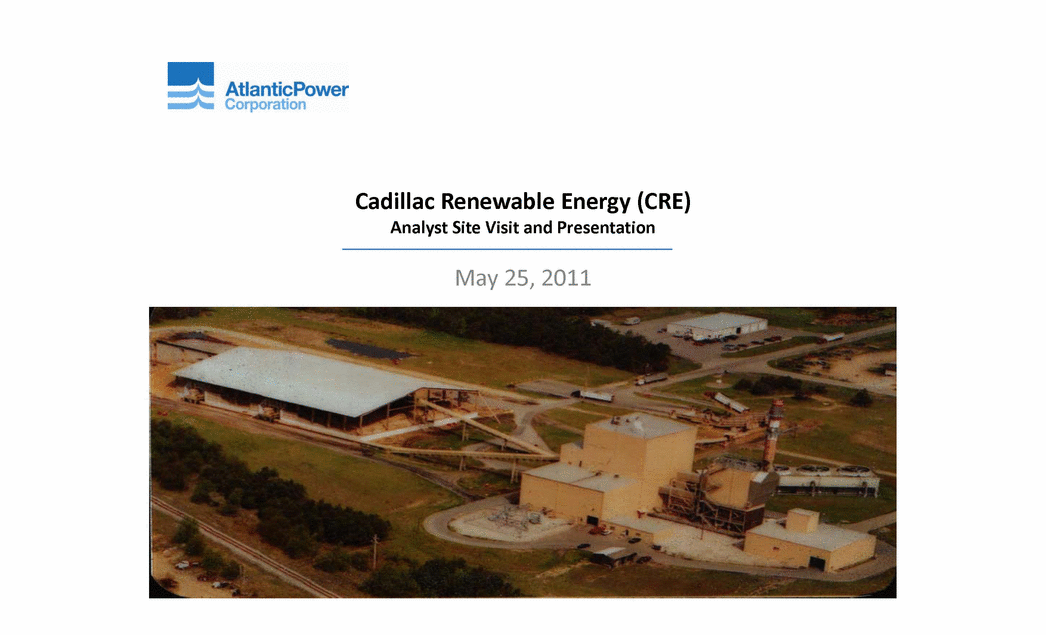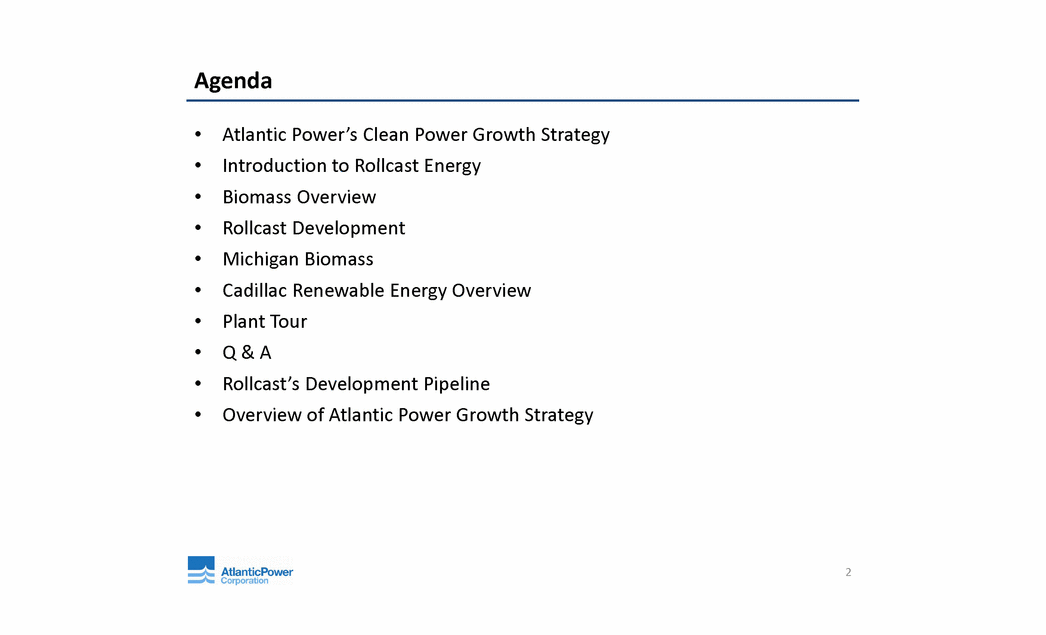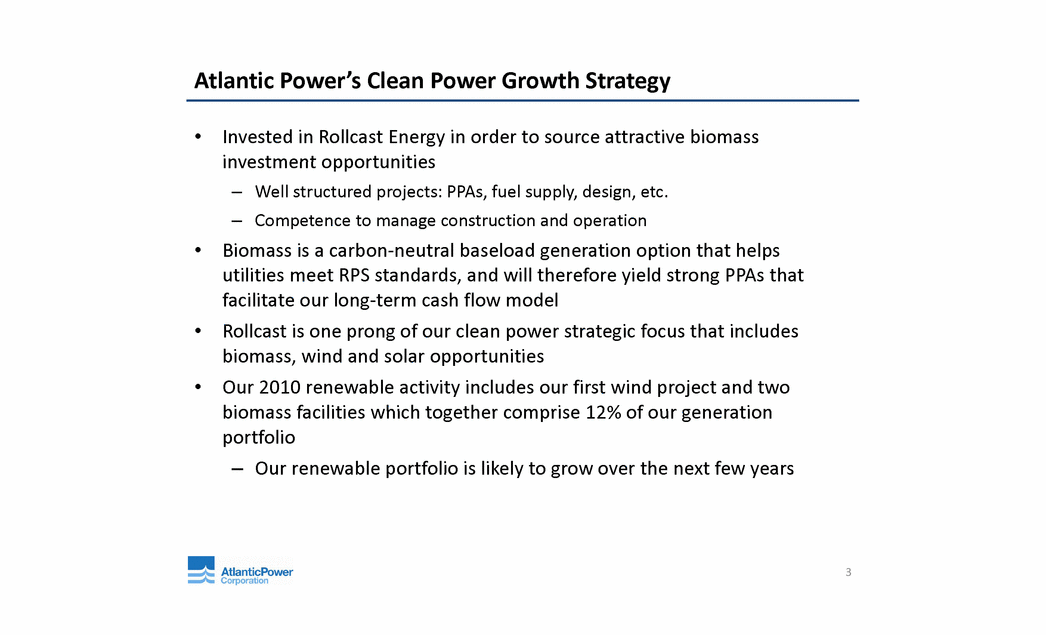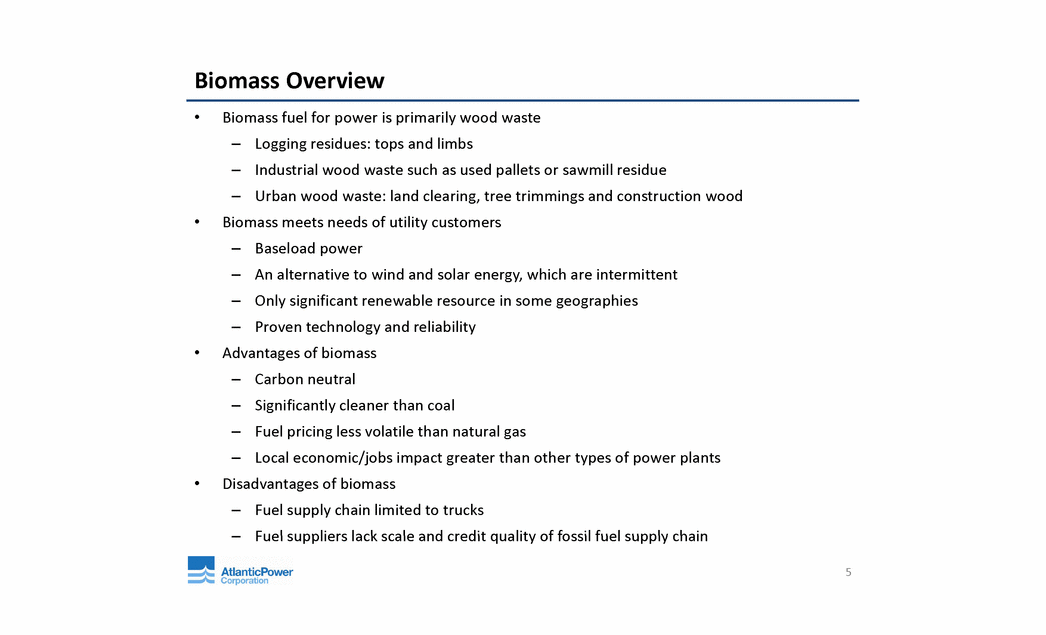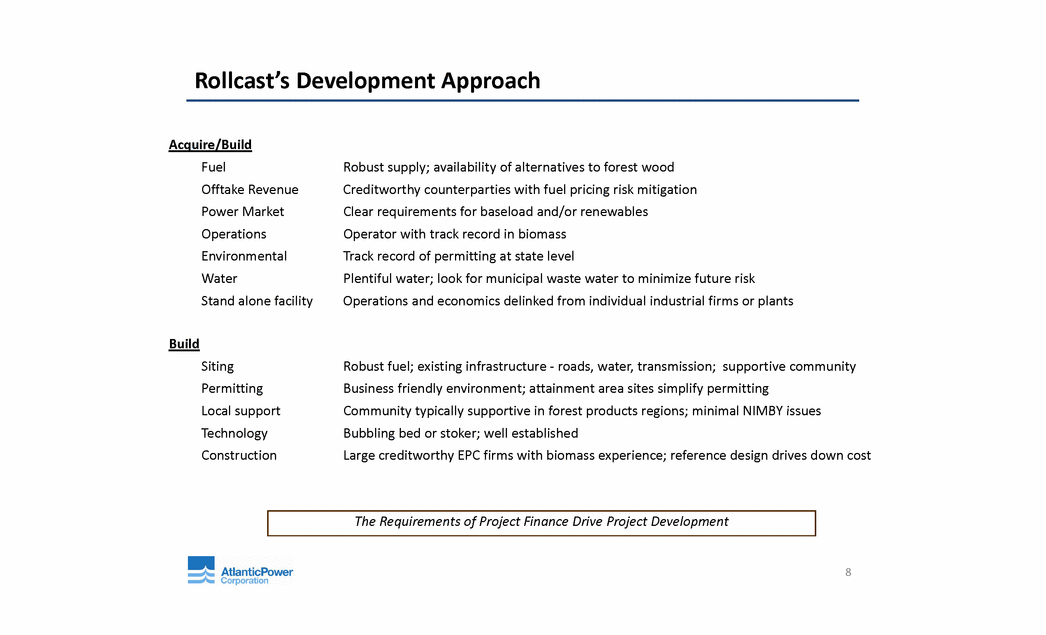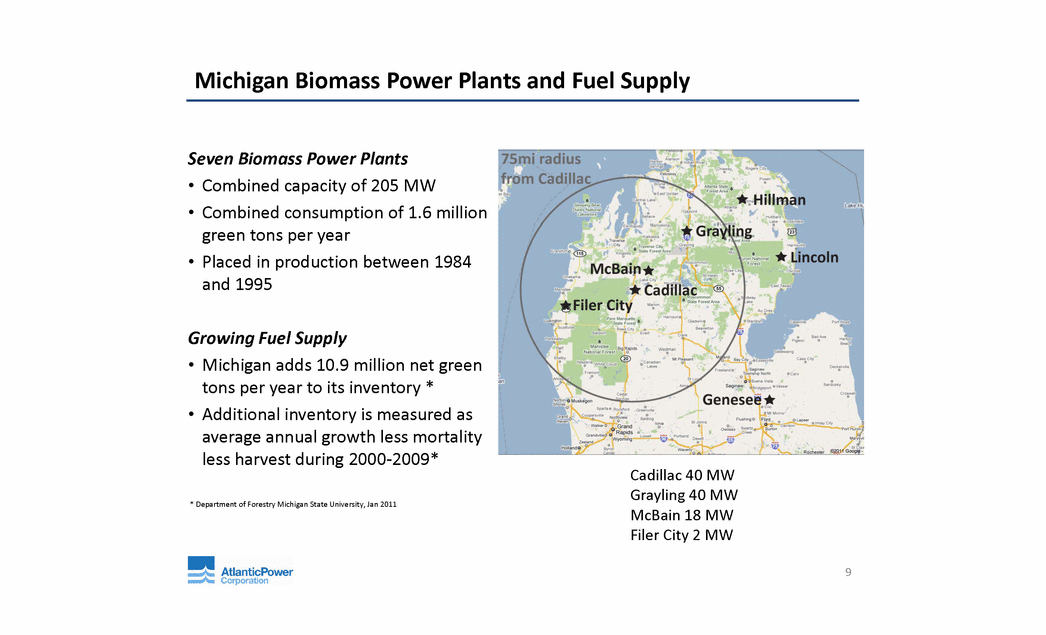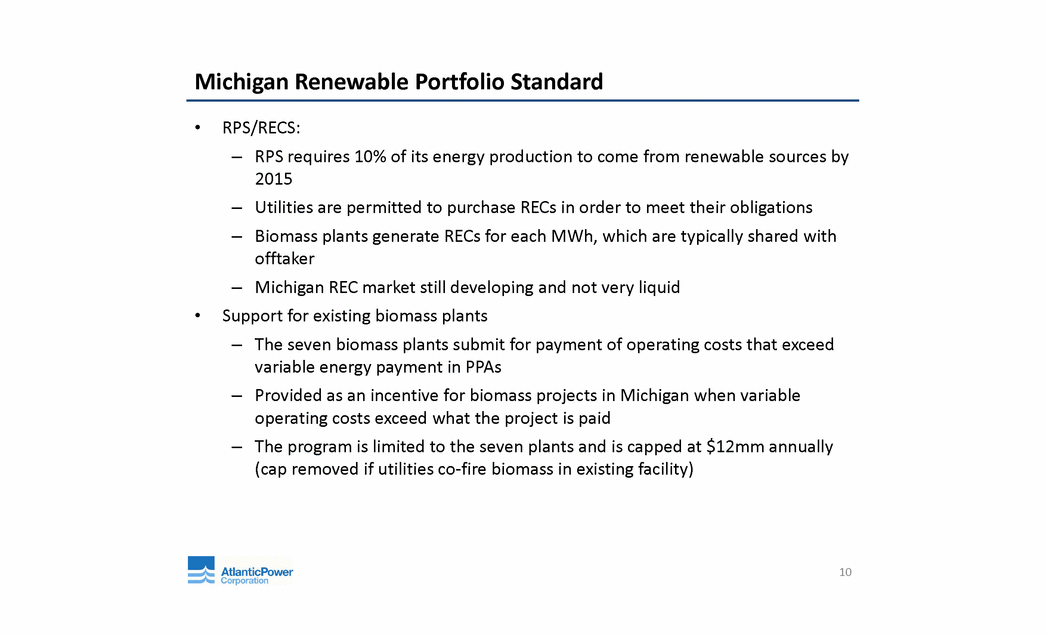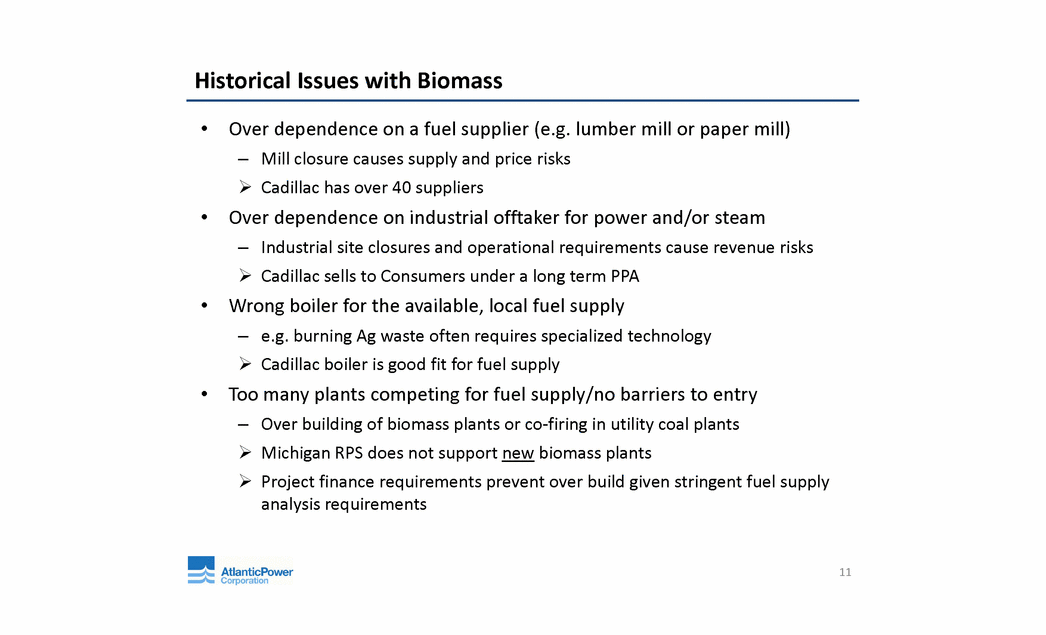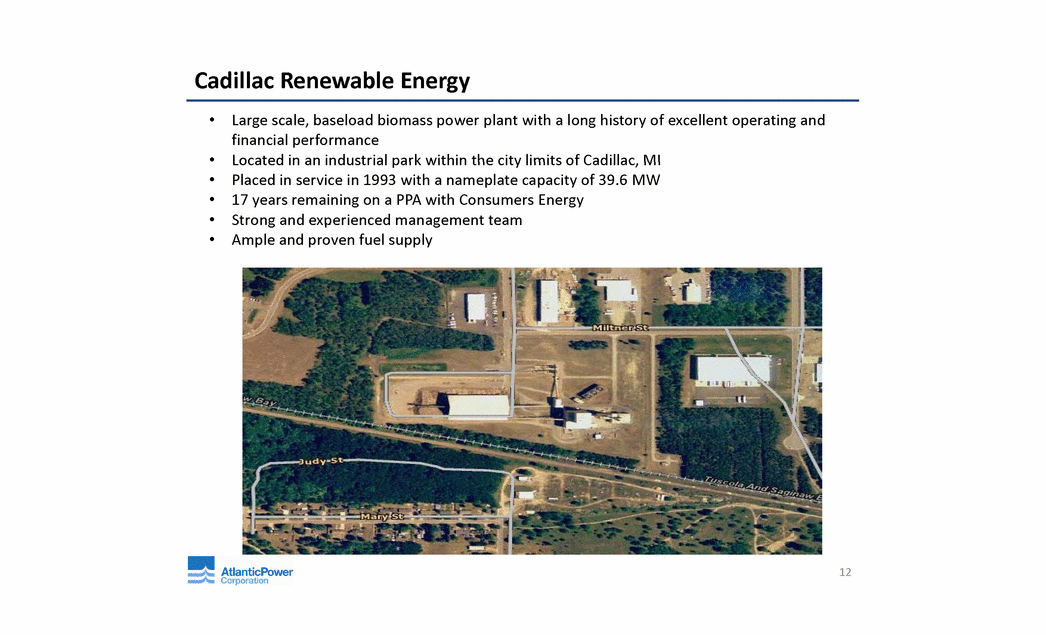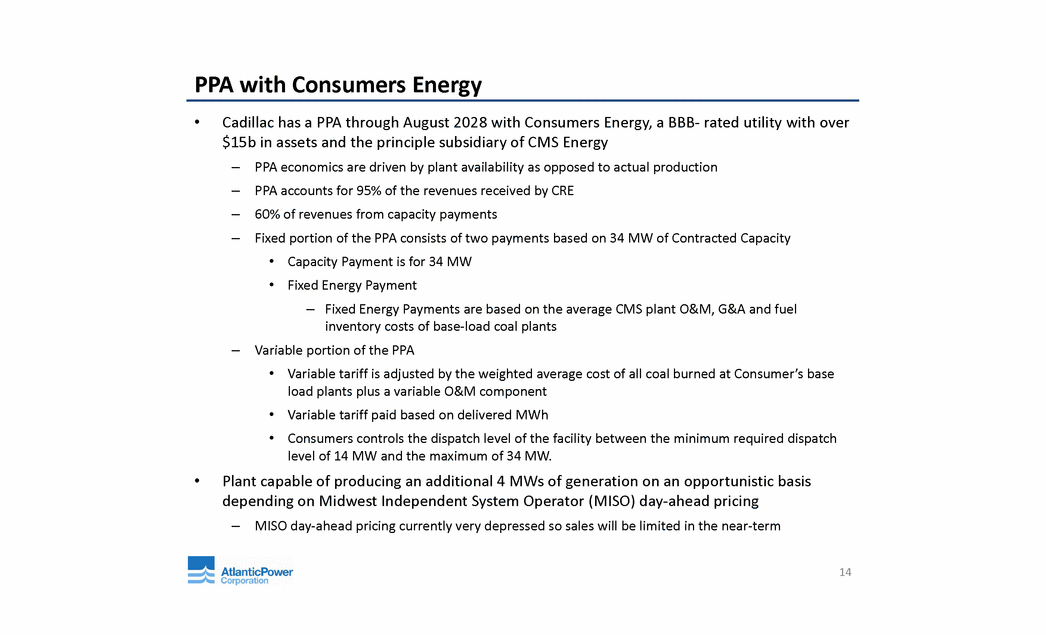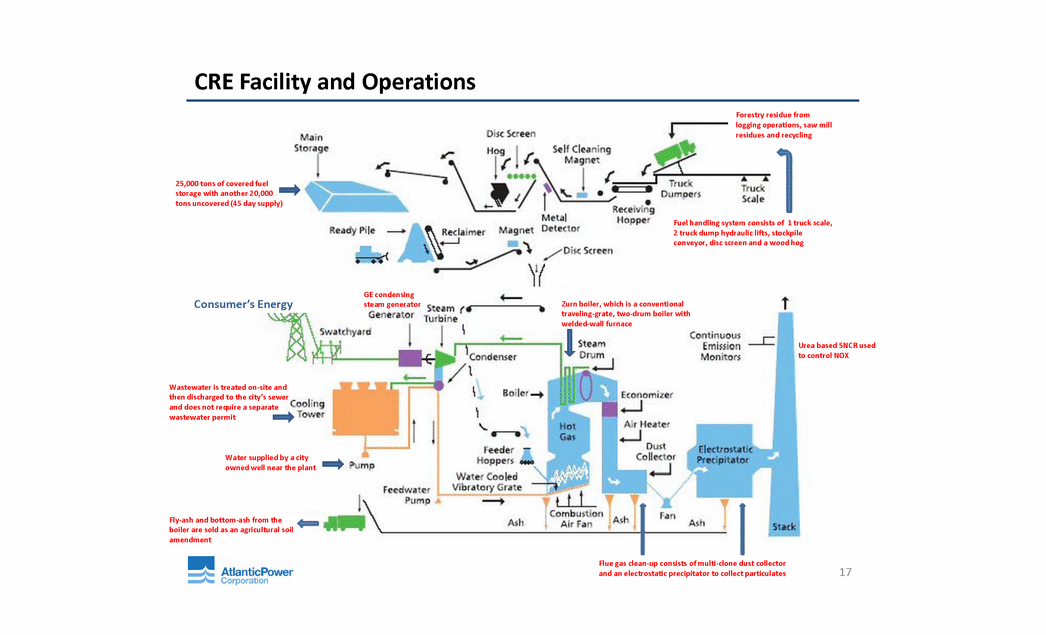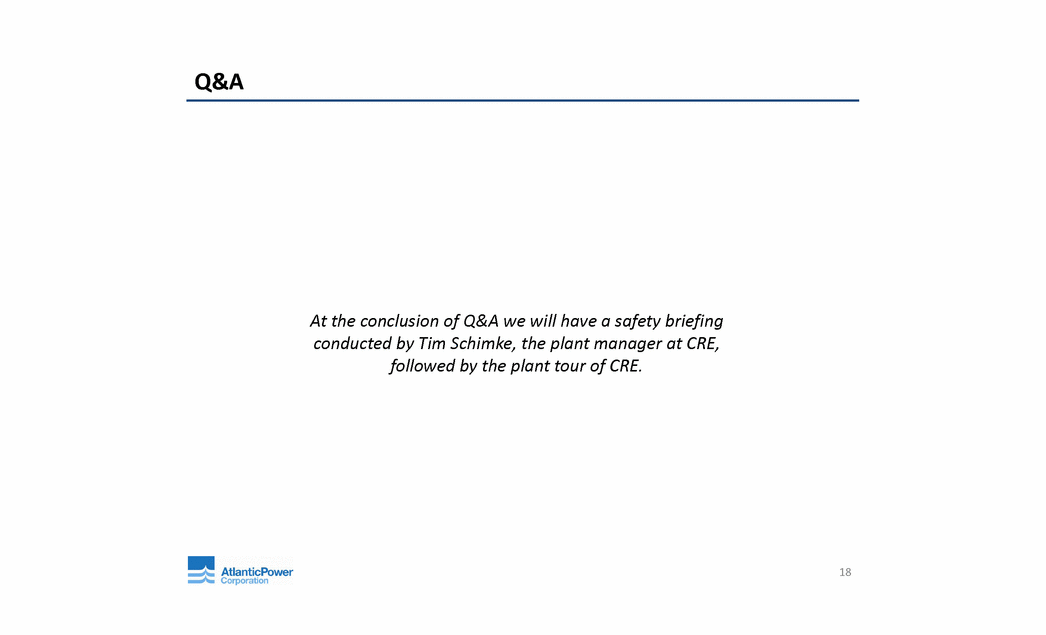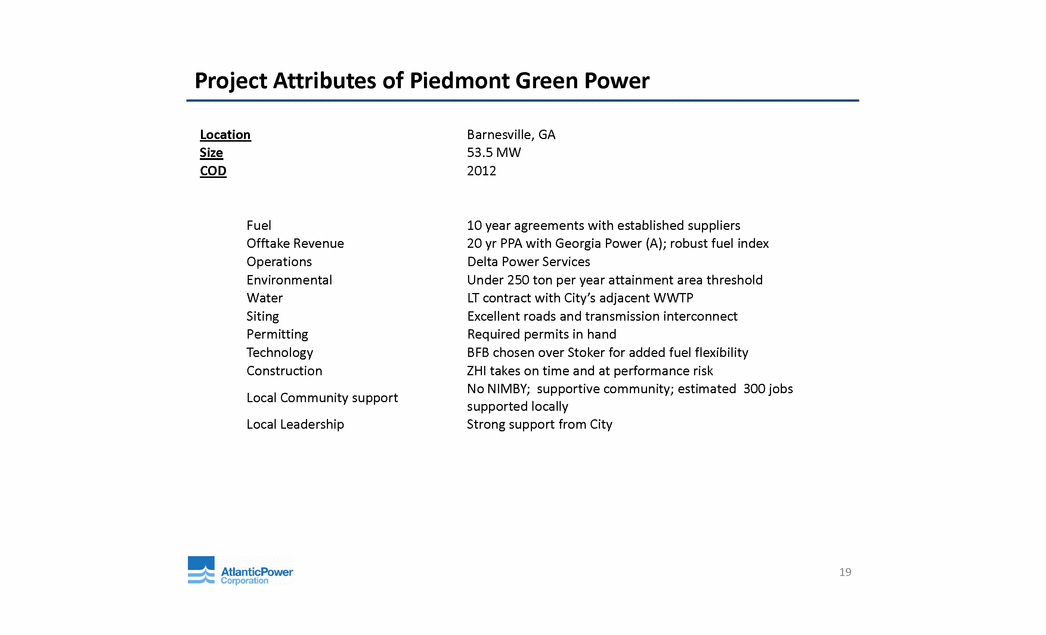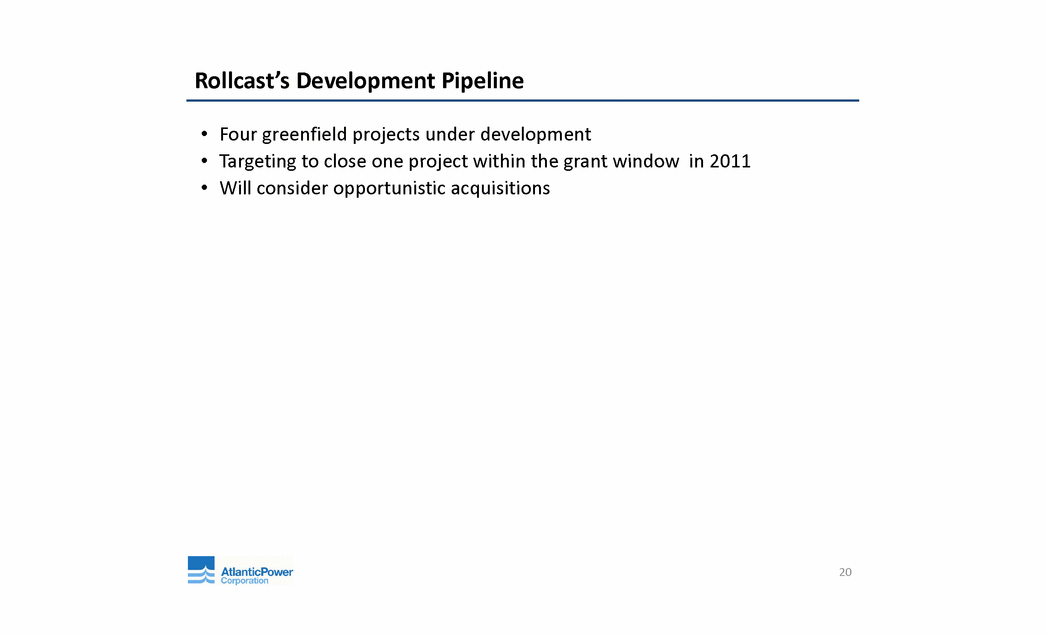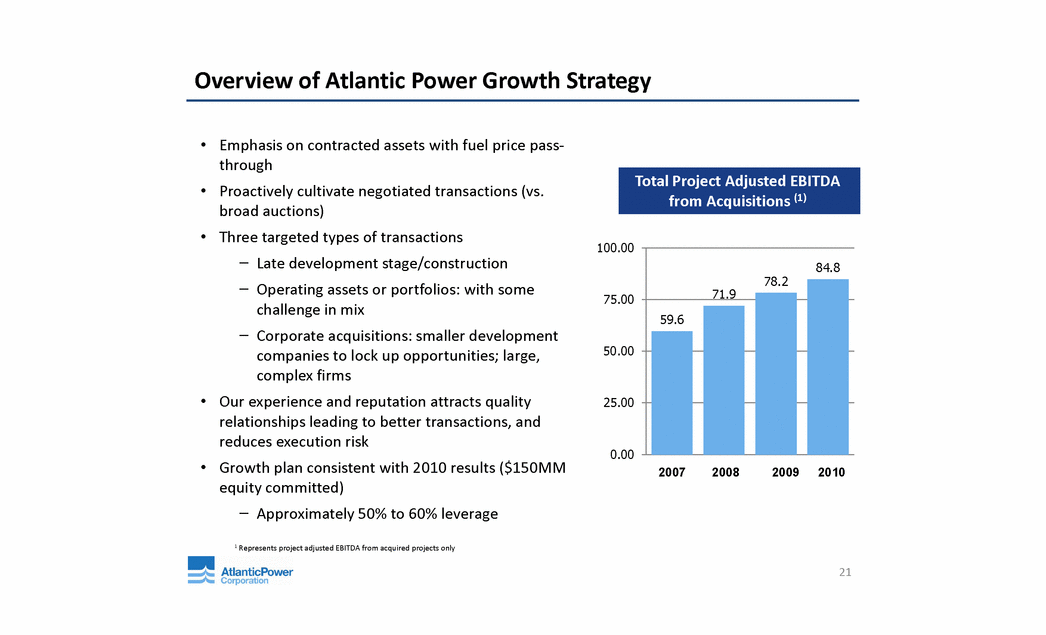Attached files
| file | filename |
|---|---|
| 8-K - 8-K - ATLANTIC POWER CORP | a11-13324_18k.htm |
Exhibit 99.1
|
|
Cadillac Renewable Energy (CRE) Analyst Site Visit and Presentation May 25, 2011 y , |
|
|
Agenda • Atlantic Power’s Clean Power Growth Strategy I t d ti t R ll t E • Introduction to Rollcast Energy • Biomass Overview R ll tD l t • Rollcast Development • Michigan Biomass C dill R bl E O i • Cadillac Renewable Energy Overview • Plant Tour Q & A • • Rollcast’s Development Pipeline O i f Atl ti P G th St t • Overview of Atlantic Power Growth Strategy 2 |
|
|
Atlantic Power’s Clean Power Growth Strategy • Invested in Rollcast Energy in order to source attractive biomass investment opportunities – Well structured projects: PPAs, fuel supply, design, etc. – Competence to construction operation manage and • Biomass is a carbon-neutral baseload generation option that helps utilities meet RPS standards, and will therefore yield strong PPAs that facilitate our long-term cash flow model • Rollcast is one prong of our clean power strategic focus that includes b d d l biomass, wind and solar opportunities • Our 2010 renewable activity includes our first wind project and two biomass facilities which together comprise 12% of our generation portfolio – Our renewable portfolio is likely to grow over the next few years 3 |
|
|
Rollcast Energy, Inc. • Rollcast Energy develops, acquires and manages biomass-fired power plants • Management has significant solid fuel experience with companies like Duke, g g p p , Southern and AEP • Rollcast’s projects meet utility customer’s baseload and renewable energy requirements • Initial geographic target is Southeastern U.S. – Excellent fuel supply – Poor wind and solar resources N df b l d – Need for baseload power – Favorable permitting environment • Rollcast greenfield has developed a significant pipeline of and acquisition opportunities • Atlantic initially ownership invested in 2009, and increased interest to 60% in 2010 • In Q4 2010, closed $130 million project financing and started construction on Piedmont Green Power (53 MW) in Barnesville, Georgia 4 |
|
|
Biomass Overview • Biomass fuel for power is primarily wood waste – Logging residues: tops and limbs – Industrial wood waste such as used pallets or sawmill residue – Urban wood waste: land clearing, tree trimmings and construction wood • utility Biomass meets needs of customers – Baseload power – An alternative to wind and solar energy, which are intermittent – Only significant renewable resource in some geographies – Proven technology and reliability Ad t f bi • Advantages of biomass – Carbon neutral – Significantly cleaner than coal g y – Fuel pricing less volatile than natural gas – Local economic/jobs impact greater than other types of power plants • Disadvantages of biomass – Fuel supply chain limited to trucks – Fuel suppliers lack scale and credit quality of fossil fuel supply chain 5 |
|
|
Biomass Power is an Established Renewable Baseload Source • Biomass makes up a significant portion of the renewable energy mix – In the U.S., biomass comprises 27%* renewable electricity generation (EIA August 2010) • Size: 9,000 MW biomass capacity in U.S.** – 2,600 MW stand-alone facilities (~110 sites) – 6,400 MW inside the fence of industrials (~180 sites) ( d l )** • Top states stand alone)** – California: 33 plants, 707 MW Maine plants – Maine: 8 plants, 295 MW – Michigan: 7 plants, 205 MW – York: 5 plants 190MW New plants, • Ownership of stand-alone facilities** – with about owners Fragmented, 30 – Largest portfolios are only a few hundred MW 6 **source: USDOE EIA Power Plant Database 2010 *including wind, solar and geothermal; excluding hydro |
|
|
Mandates and Incentives for Renewable Projects Federal and State Incentives Support A i iti d N B ild Renewable Portfolio Standards in 32 States Support G fildD l t Acquisitions and New Build • Credit Greenfield Development Production Tax • Investment Tax Credit and Cash Grant • Accelerated Depreciation • Renewable Portfolio Standards Data from June 2010 7 |
|
|
Rollcast’s Development Approach Acquire/Build l b l lbl f l f d Fuel Robust supply; availability of alternatives to forest wood Offtake Revenue Creditworthy counterparties with fuel pricing risk mitigation Power Market Clear requirements for baseload and/or renewables Operations Operator with track record in biomass Environmental Track record of permitting at state level Water Plentiful water; look for municipal waste water to minimize future risk Stand alone facility Operations and economics delinked from individual industrial firms or plants Build Siting Robust fuel; existing infrastructure - roads, water, transmission; supportive community Permitting Business friendly environment; attainment area sites simplify permitting Local support Community supportive in forest products minimal NIMBY typically regions; issues Technology Bubbling bed or stoker; well established Construction Large creditworthy EPC firms with biomass experience; reference design drives down cost The Requirements of Project Finance Drive Project Development 8 |
|
|
Michigan Biomass Power Plants and Fuel Supply Biomass Power Seven Plants • Combined capacity of 205 MW • Combined consumption of 1.6 million green tons per year • Placed in production between 1984 and 1995 Growing Fuel Supply • Michigan adds 10.9 million net green tons per year to its inventory * Additi l i t i d • Additional inventory is measured as average annual growth less mortality less harvest during 2000-2009* Cadillac * Department of Forestry Michigan State University, Jan 2011 40 MW Grayling 40 MW McBain 18 MW 9 Filer City 2 MW |
|
|
Michigan Renewable Portfolio Standard • RPS/RECS: – of its energy production to RPS requires 10% come from renewable sources by 2015 – Utilities are permitted to purchase RECs in order to meet their obligations – Biomass plants generate RECs for each MWh, which are typically shared with offtaker still – Michigan REC market developing and not very liquid • Support for existing biomass plants – The seven biomass plants submit for payment of operating costs that exceed variable energy payment in PPAs – Provided as an incentive for biomass projects in Michigan when variable d h h d operating costs exceed what the project is paid – The program is limited to the seven plants and is capped at $12mm annually (removed if utilities co-cap co fire biomass in existing facility) 10 |
|
|
Historical Issues with Biomass • Over dependence on a fuel supplier (e.g. lumber mill or paper mill) – causes Mill closure supply and price risks Cadillac has over 40 suppliers • Over dependence on industrial offtaker for power and/or steam p p / – Industrial site closures and operational requirements cause revenue risks Cadillac sells to Consumers under a long term PPA • Wrong boiler for the available, local fuel supply – e.g. burning Ag waste often requires specialized technology Cadillac boiler is good fit for fuel supply • Too many plants competing for fuel supply/no barriers to entry – Over building of biomass plants or co-firing in utility coal plants Michigan RPS does not support new biomass plants Project finance requirements prevent over build given stringent fuel supply analysis requirements 11 |
|
|
Cadillac Renewable Energy • Large scale, baseload biomass power plant with a long history of excellent operating and financial performance • Cadillac Located in an industrial park within the city limits of Cadillac, MI • Placed in service in 1993 with a nameplate capacity of 39.6 MW • 17 years remaining on a PPA with Consumers Energy • Strong and management team experienced • Ample and proven fuel supply 12 |
|
|
CRE Fuel Overview • Fuel Supply/Mix – CRE is located in an area with a healthy forest products industry. – annual wood generated within 75 miles CRE’s The waste of CRE is equivalent to nearly 5x CRE s requirements – Grayling and McBain have overlapping fuel supply circles, the majority of Cadillac’s suppliers have an economic incentive to deliver to Cadillac based on location of supply relative to the plant – Fuel mix is primarily forestry residue from logging operations accounting for nearly 75% of supply – Balance of supply from saw mill residues and recovery of other wood material • Procurement Strategy C ili l b f li 0 ) f f f l i h C fi d – CRE utilizes a large number of suppliers ( 40+) from a range of fuel sources ensuring that CRE finds a competitive supply – No one supplier should account for more than 15% of supply (preserves diversity and competition) M i t i d t i t l l ith f t d l i t – Maintain prudent inventory levels with an average of 30 to 45 days supply in storage – Seasonal build-up to protect against low receipts during winter months – Dedicated fuel procurement manager who has continuous contact with suppliers, professional organizations forces and frequent monitoring of competitive forces. – Majority of suppliers have sold fuel to CRE since inception • Fuel Pricing – Diesel fuel is a key component of biomass fuel price and can account for up to 50% of the overall fuel cost – Each ton of biomass fuel requires approximately 2.5 gallons of diesel to process and transport to facility (50 to 75 miles on average) – Michigan RPS fuel and variable O&M subsidy provides some protection against fuel price increases up to a monthly cap 13 |
|
|
PPA with Consumers Energy • Cadillac has a PPA through August 2028 with Consumers Energy, a BBB- rated utility with over $15b in assets and the principle subsidiary of CMS Energy d b l lbl d l d – PPA economics are driven by plant availability as opposed to actual production – PPA accounts for 95% of the revenues received by CRE – 60% of revenues from capacity payments – Fixed portion of the PPA consists of two payments based on 34 MW of Contracted Capacity • Capacity Payment is for 34 MW • Fixed Payment Energy – Fixed Energy Payments are based on the average CMS plant O&M, G&A and fuel inventory costs of base-load coal plants PPA – Variable portion of the • Variable tariff is adjusted by the weighted average cost of all coal burned at Consumer’s base load plants plus a variable O&M component V i bl t iff idb d d li dMWh • Variable tariff paid based on delivered MWh • Consumers controls the dispatch level of the facility between the minimum required dispatch level of 14 MW and the maximum of 34 MW. • Plant capable of producing an additional 4 MWs of generation on an opportunistic basis depending on Midwest Independent System Operator (MISO) day-ahead pricing – MISO day-ahead pricing currently very depressed so sales will be limited in the near-term 14 |
|
|
CRE Operations • Operations and Maintenance – Long-term O&M contract with Delta Power Services ( DPS) expires concurrently with the g ) p y PPA – Plant management has been with the facility since its COD in 1993 with overall average staff tenure at seven years – Routine maintenance performed in-house with contractors to supplement capabilities – Best-in-class operating history that has resulted in an average availability factor of 93% since 2000 and over the past 3 years nearly 95% – Excellent environmental and safety record since inception • Asset Management – CRE has an agreement with Rollcast Energy, Inc. to provide commercial/operational asset management services – Phil Smith, Rollcast VP, Asset Management has nearly 30 years experience in the power industry in asset management and back-office operations in a variety of technologies (biomass, coal, natural gas and hydro) • Back-office Support pp – Atlantic Power provides all back-office support to CRE including accounting, cash receipts and disbursements, and treasury 15 |
|
|
Summary • Solid project attributes supporting steady and predictable cash flows – Favorable biomass regulatory environment – Michigan RPS law provides value to RECs as well as fuel and variable O&M subsidy entry for new biomass projects since RPS fuel – Barrier to and variable O&M subsidy is limited to seven existing facilities only – Long-term PPA with creditworthy utility – Ample and proven fuel supply – Attractive and predictable economics with well understood and recurring cash flows – Strong and experienced management team – Long term history of excellent operating and financial performance – Strong environmental and safety record – Revenue upside with further development of REC market and sale of merchant MWs 16 |
|
|
CRE Facility and Operations Forestry residue from logging operations, saw mill residues and recycling 25,000 tons of covered fuel storage with another 20,000 tons uncovered (45 day supply) handling system consists of 1 truck scale Fuel scale, 2 truck dump hydraulic lifts, stockpile conveyor, disc screen and a wood hog Zurn boiler, which is a conventional traveling-grate, two-drum boiler with welded-wall furnace GE condensing steam generator Urea based SNCR used Consumer’s Energy to control NOX Wastewater is treated on-site and then discharged to the city’s sewer and does not require a separate Water supplied by a city owned well near the plant wastewater permit Fly-ash and bottom-ash from the boiler are sold as an agricultural soil Flue gas clean-up consists of multi-clone dust collector and an electrostatic precipitator to collect particulates amendment 17 |
|
|
Q&A At the conclusion of Q&A we will have a safety briefing conducted by Tim Schimke, the plant manager at CRE, followed by the plant tour of CRE. 18 |
|
|
Project Attributes of Piedmont Green Power Location Barnesville, GA Size 53.5 MW COD 2012 Fuel 10 year agreements with suppliers established Offtake Revenue 20 yr PPA with Georgia Power (A); robust fuel index Operations Delta Power Services Environmental Under 250 ton per year attainment area threshold p y Water LT contract with City’s adjacent WWTP Siting Excellent roads and transmission interconnect Permitting Required permits in hand T h l BFB h St k f dd d f l fl ibilit Technology chosen over Stoker for added fuel flexibility Construction ZHI takes on time and at performance risk Local Community support No NIMBY; supportive community; estimated 300 jobs supported locally pp y Local Leadership Strong support from City 19 |
|
|
Rollcast’s Development Pipeline • Four greenfield projects under development • Targeting to close one project within the grant window in 2011 • Will consider opportunistic acquisitions 20 |
|
|
Overview of Atlantic Power Growth Strategy • Emphasis on contracted assets with fuel price passth h through • Proactively cultivate negotiated transactions (vs. broad auctions) Total Project Adjusted EBITDA from Acquisitions (1) • Three targeted types of transactions - Late development stage/construction O ti t tf li ith 78.2 84.8 100.00 - Operating assets or portfolios: with some challenge in mix - Corporate acquisitions: smaller development 59.6 71.9 50 00 75.00 companies to lock up opportunities; large, complex firms • Our experience and reputation attracts quality 25.00 50.00 relationships leading to better transactions, and reduces execution risk • Growth plan consistent with 2010 results ($ 150MM 0.00 2007 2008 2009 2010 p equity committed) - Approximately 50% to 60% leverage 21 1 Represents project adjusted EBITDA from acquired projects only |

